The VVT Actuators Market is estimated to be valued at USD 2.5 billion in 2025 and is projected to reach USD 4.3 billion by 2035, registering a compound annual growth rate (CAGR) of 5.5% over the forecast period.
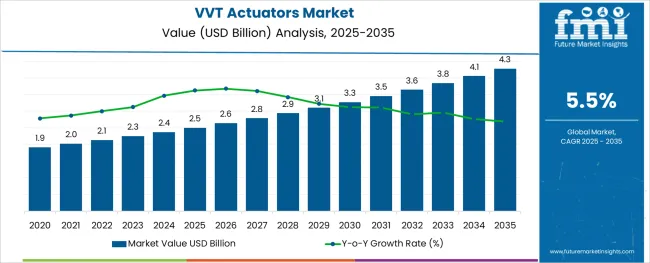
The VVT actuators market is experiencing a period of resilient growth as internal combustion engines remain prevalent in global vehicle production despite the rise of electrification. Manufacturers are prioritizing variable valve timing technologies to meet stricter fuel efficiency and emission norms without compromising performance. VVT actuators are being increasingly integrated into engines to optimize airflow dynamics, improve throttle response, and reduce unburned hydrocarbons.
Key automotive OEMs are investing in actuator innovation that enables faster response times, reduced friction, and lower oil consumption. Furthermore, advancements in compact actuator packaging and electric actuation mechanisms are expanding compatibility across engine platforms.
Market growth is expected to continue, particularly in regions where hybrid vehicle adoption requires sophisticated valvetrain control. Continued R&D in dual VVT systems and modular actuator architectures is anticipated to support market demand through extended application in both passenger and light commercial vehicles.
The market is segmented by Placement Side, Implementation Method, and End Use and region. By Placement Side, the market is divided into Intake Side, Exhaust Side, and Others. In terms of Implementation Method, the market is classified into Cam Switching, Cam Phasing, Oscillating Cam, Eccentric Cam Drive, Three to Dimensional Cam Lobe, Two Shaft Combined Cam Lobe Profile, Coaxial Two Shaft Combined Cam Lobe Profile, Helical Camshaft, and Camless Engines.
Based on End Use, the market is segmented into Automotive, Aerospace & Avionics, Marine, and Others. Regionally, the market is classified into North America, Latin America, Western Europe, Eastern Europe, Balkan & Baltic Countries, Russia & Belarus, Central Asia, East Asia, South Asia & Pacific, and the Middle East & Africa.
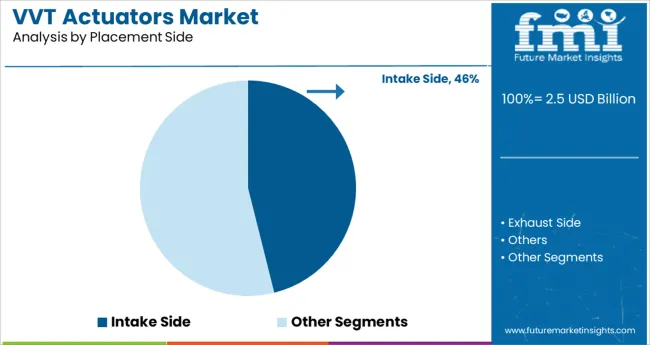
The intake side is projected to hold 46.1% of the total VVT actuators market revenue in 2025, establishing it as the leading placement side. This segment's dominance is attributed to its crucial role in controlling the air intake volume and timing, which significantly influences combustion efficiency and engine responsiveness.
Intake side VVT actuators are often prioritized in budget-sensitive engine designs where fuel economy improvement is the key target. The ability to independently modulate intake valve timing allows manufacturers to meet emission regulations while optimizing low-end torque and throttle behavior.
Simplified integration and a favorable cost-to-benefit ratio have further supported adoption. These factors combined with increasing use in compact and mid-range passenger vehicles continue to position the intake side as the most widely implemented VVT actuator configuration.
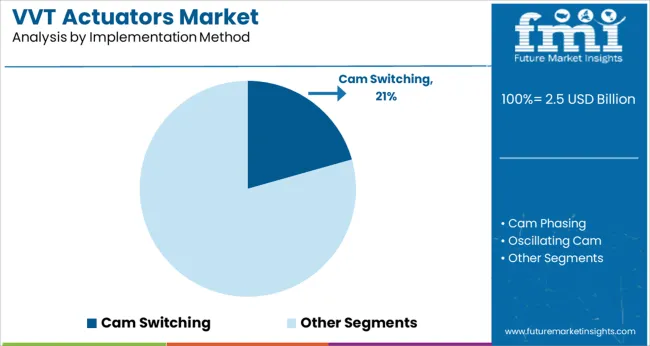
Cam switching is projected to account for 20.6% of the implementation method segment revenue in 2025, making it a significant contributor to VVT actuator integration. This method enables discrete shifts between different cam profiles, offering a simplified yet effective means of enhancing engine flexibility and fuel economy.
Cam switching is especially suitable for engines designed to operate across a wide RPM range, where performance and efficiency must be balanced. Its mechanical simplicity and reduced dependency on complex electronics make it favorable for mid-tier and economy vehicle segments.
Additionally, durability and ease of maintenance have made cam switching a preferred method in markets with extended vehicle usage cycles. These advantages have contributed to its sustained share in the implementation strategy within the VVT actuator market.
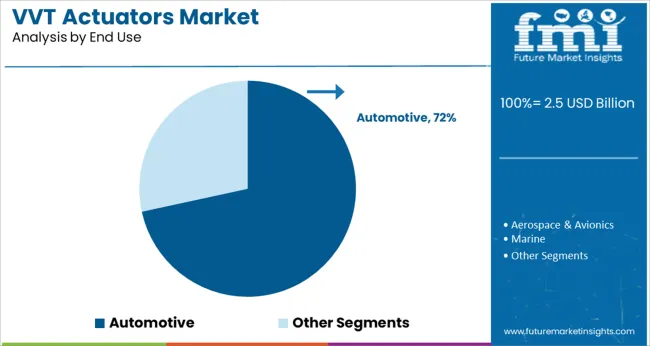
The automotive segment is expected to dominate the VVT actuators market with a 71.6% revenue share in 2025. This leadership position is supported by the extensive use of VVT actuators in passenger cars, commercial vehicles, and hybrid engine configurations.
Automotive OEMs continue to rely on VVT technologies to comply with emission norms such as Euro 6 and CAFE standards while delivering enhanced performance and drivability. The widespread production of internal combustion engines across Asia Pacific and North America has created strong demand for reliable and scalable VVT actuator systems.
Moreover, the increasing integration of dual VVT systems in modern engines has accelerated component usage per unit. The automotive sector's consistent focus on thermal efficiency, emission control, and engine downsizing has reinforced the role of VVT actuators as essential components, ensuring the segment maintains its leading position in the market through the forecast period.
Rising automation in the automotive industry is one of the primary factors driving the sales of VVT actuators. Over the projection period, it is anticipated that the global automotive market is poised to grow steadily due to increased disposable income.
As a result of this, it is projected that a sizable portion of demand for VVT actuators is anticipated to come from emerging economies.
The VVT actuators market size is anticipated to rise due to the growing emphasis on enhancing fuel efficiency and implementing automation for improved control. Furthermore, the demand is rising as a result of the increased use of VVT actuators by regional and local automakers.
The sales of VVT actuator is likely to witness swift growth as many nations are likely to make it mandatory for VVT actuators to be used in passenger cars due to rising fuel efficiency. This factor is likely to have a positive impact on the global VVT actuators market.
Additionally, the demand for VVT actuators has increased with the development of autonomous automobiles, and this factor is anticipated to drive the global VVT actuators market throughout the forecast period. The rising cost of VVT Actuators, however, keeps the technology limited to expensive cars.
During the Actuator Test, Normal Idle
The waveform can be used to verify the proper operation of the variable valve timing circuit mechanically, hydraulically, and electrically. VVT actuators are essential for testing the engine's dynamic valve timing, which is another factor anticipated to boost the demand during the forecast period.
Tests of In-Cylinder Pressure
With the engine running, the in-cylinder conditions can be examined using a pressure transducer. This test can check the valve timing and look for problems with cylinder sealing.
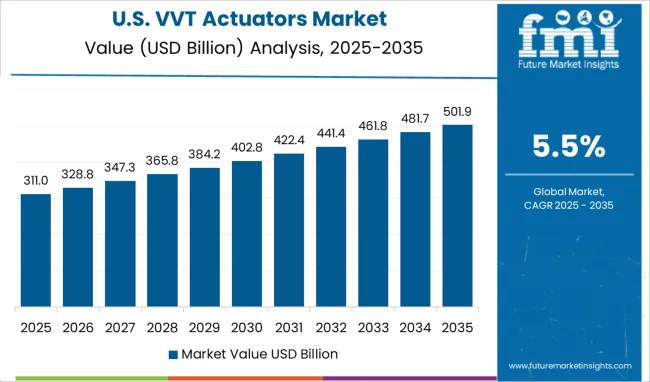
During the forecast period, North America is expected to hold the second largest share of 12.0% in the global VVT actuators market. The growth in the region is owing to the presence of some of the most cutting-edge automotive automation technology and the high rate of technological adoption.
Demand for VVT actuators in the USA is predicted to soar by the conclusion of the projection period as more businesses enter the autonomous vehicle market. Furthermore, it is anticipated that over the projection period, Latin America is projected to increase its demand for automobiles, which is likely to increase the region's sales of VVT actuators.
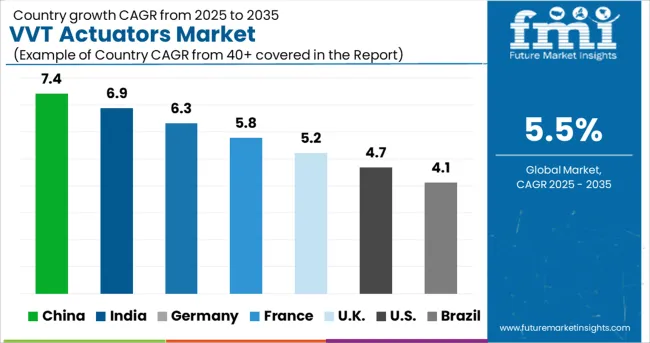
Europe is projected to hold the largest share of 22% in the VVT actuators market during the forecast period. Due to the presence of some of the most well-known manufacturers in this region, the demand for VVT actuators has increased. The majority of passenger buses and cars in the European areas have VVT actuators, which encourage fuel efficiency.
Furthermore, VVT Actuators are witnessing high demand in Eastern Europe, not just from the automotive and marine industries but also from the aerospace industry.
Startups Strengthening their Foothold in the Market by following Latest Trends
Installing twin VVT actuators in compact-size passenger car engines is one of the most recent innovations that are likely to take off in the global VVT actuators market. The startups in the VVT actuators market are concentrating on giving tiny-size cars dual VVT systems in order to increase their fuel efficiency and engine power output.
Furthermore, OEMs are increasingly working on downsizing engines to lower the overall curb weight and increase mileage numbers as customers are being compelled by fluctuating fuel prices to purchase fuel-efficient vehicles.
In the forecast period, the VVT actuators market is projected to expand as a result of consumer demand for fuel-efficient automobiles since dual VVT systems provide a lightweight, affordable solution for increasing fuel efficiency and controlling emissions.

What are the Growth Strategies followed by Key Players in the VVT Actuators Market?
Few well-known companies dominate the global VVT actuators market. The major players in the market are concentrating on expanding their clientele and boosting their R&D expenditures. The level of competition in the market is likely to increase due to advancements in technology and governmental laws.
The majority of market developments are a result of the increase in sales of mid and full-size passenger cars, and manufacturers are gradually adding cruise control and VVT systems with the help of VVT actuators to compact cars to boost their performance and fuel economy.
The key market players profiled in the report include Mikuni American Corporation, Autorun, Delphi Automotive LLP, Mitsubishi Electric Corporation, Metal Seal Precision, Ltd., and Zhejiang DiMa Vehicle Industry Company.
Recent Developments in the VVT Actuators Market:
| Report Attribute | Details |
|---|---|
| Growth Rate | CAGR of 5.5% from 2025 to 2035 |
| Base Year for Estimation | 2025 |
| Historical Data | 2020 to 2024 |
| Forecast Period | 2025 to 2035 |
| Quantitative Units | Revenue in USD million and CAGR from 2025 to 2035 |
| Report Coverage | Revenue Forecast, Volume Forecast, Company Ranking, Competitive Landscape, Growth Factors, Trends and Pricing Analysis |
| Segments Covered | Placement Side, Implementation Method, End Use Application, Region |
| Regions Covered | North America, Latin America, Europe, East Asia, South Asia, Oceania, Middle East and Africa |
| Key Countries Profiled | USA, Canada, Brazil, Argentina, Germany, UK, France, Spain, Italy, Nordics, BENELUX, Australia &, New Zealand, China, India, ASEAN, GCC, South Africa |
| Key Companies Profiled | Mitsubishi Electric Corporation, Camcraft, Inc., Metal Seal Precision, Ltd., Mikuni American Corporation, Zhejiang DiMa Vehicle Industry Company, Autorun, GOGO Automatic Company Ltd, Delphi Automotive LLP |
| Customization | Available Upon Request |
The global vvt actuators market is estimated to be valued at USD 2.5 billion in 2025.
It is projected to reach USD 4.3 billion by 2035.
The market is expected to grow at a 5.5% CAGR between 2025 and 2035.
The key product types are intake side, exhaust side and others.
cam switching segment is expected to dominate with a 20.6% industry share in 2025.






Full Research Suite comprises of:
Market outlook & trends analysis
Interviews & case studies
Strategic recommendations
Vendor profiles & capabilities analysis
5-year forecasts
8 regions and 60+ country-level data splits
Market segment data splits
12 months of continuous data updates
DELIVERED AS:
PDF EXCEL ONLINE
Safety Actuators Market Size and Share Forecast Outlook 2025 to 2035
Linear Actuators Market
Engine Actuators Market
Market Share Insights of Aerosol Actuators Product Providers
Aircraft Actuators Market Size and Share Forecast Outlook 2025 to 2035
Robotics Actuators Market Size and Share Forecast Outlook 2025 to 2035
Industrial Valve Actuators Market
Automotive Lighting Actuators Market Size and Share Forecast Outlook 2025 to 2035
Automotive Electric Actuators Market Size and Share Forecast Outlook 2025 to 2035

Thank you!
You will receive an email from our Business Development Manager. Please be sure to check your SPAM/JUNK folder too.
Chat With
MaRIA